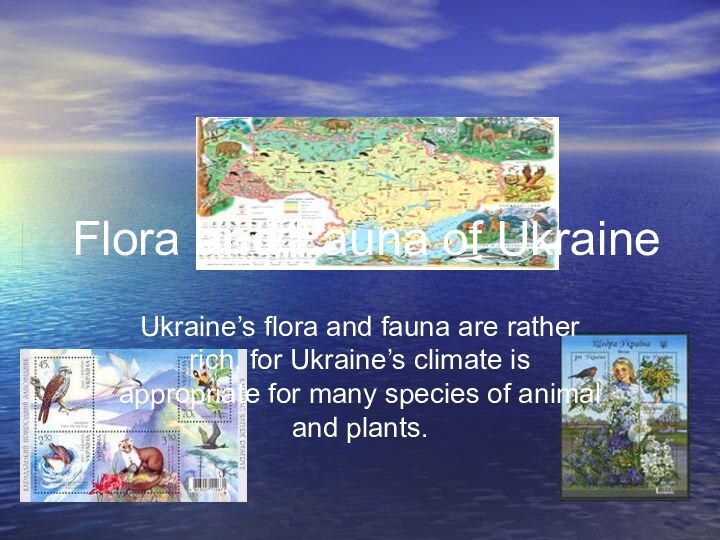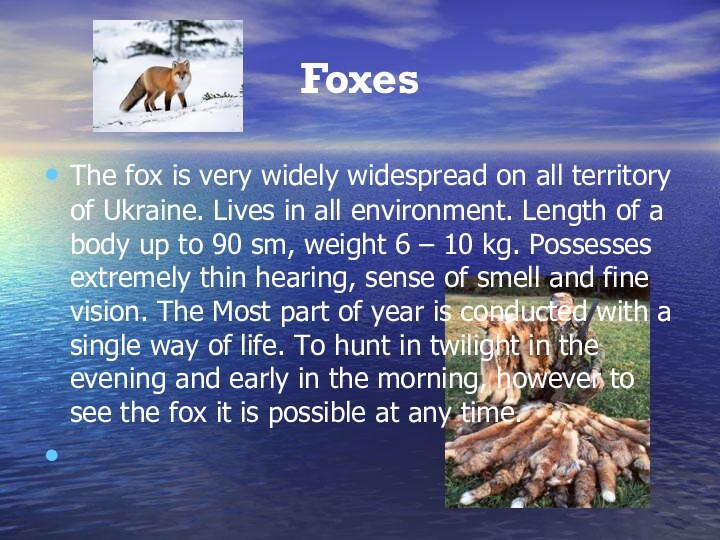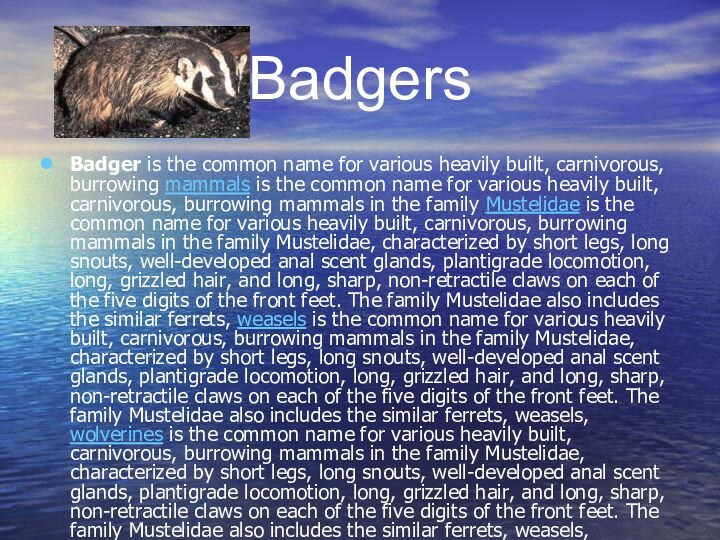- Главная
- Разное
- Бизнес и предпринимательство
- Образование
- Развлечения
- Государство
- Спорт
- Графика
- Культурология
- Еда и кулинария
- Лингвистика
- Религиоведение
- Черчение
- Физкультура
- ИЗО
- Психология
- Социология
- Английский язык
- Астрономия
- Алгебра
- Биология
- География
- Геометрия
- Детские презентации
- Информатика
- История
- Литература
- Маркетинг
- Математика
- Медицина
- Менеджмент
- Музыка
- МХК
- Немецкий язык
- ОБЖ
- Обществознание
- Окружающий мир
- Педагогика
- Русский язык
- Технология
- Физика
- Философия
- Химия
- Шаблоны, картинки для презентаций
- Экология
- Экономика
- Юриспруденция
Что такое findslide.org?
FindSlide.org - это сайт презентаций, докладов, шаблонов в формате PowerPoint.
Обратная связь
Email: Нажмите что бы посмотреть
Презентация на тему Flora and Fauna of Ukraine
Содержание
- 3. The wildlife of the country The wildlife
- 4. Wolves In Ukraine the wolf is
- 5. FoxesThe fox is very widely widespread on
- 6. BadgersBadger is the common name for various
- 7. DeerThere are inhabited mostly European and spotted
- 8. ElksThe elk or wapiti (Cervus canadensis) is
- 9. Rivers and LakesRivers and lakes of Ukraine
- 10. Unique flora and fauna of the Carpathians
- 11. Скачать презентацию
- 12. Похожие презентации
Forests of Ukraine Forests of Ukraine As for the forests, Ukraine has deciduous and coniferous trees, like pine, fir-tree, oak,











Слайд 3
The wildlife of the country
The wildlife of
the country amazes with diversity and beauty. There are
hundreds of species of birds, plants and animals in Ukraine. Ukrainian steppes and forests are inhabited by wolves and foxes, badgers and deer, elks and hamsters, field mice and so on. Some of the animals were brought here from other corners of the world and have acclimatized successfully. Among them some fur animals are: mink, musk-rat, silver-black fox and others. Today ostrich farms are wide-spread all over the country.
Слайд 4
Wolves
In Ukraine the wolf is widespread everywhere.
Especially greater concentration of the wolf is observed to
Polesye. Length of a body of 105-160 sm, weight – 30-70 kg. The wolf – very close animal, on districts is guided mainly by means of sense of smell and hearing, vision is developed more poorly, and still at night sees better a dog. The basic food to wolves serve wild and house artiodactyl: roe deer, a wild boar, a deer, a hare, etc. the Wolf causes huge damage to the hunting facilities. They form the wolf flight and very effectively hunt together, extracting even such large animals, as an elk. The hunting area of wolves reaches 50 – 60 km in radius. Speed of run of the wolf about 80 km at an o'clock. Hunting for the wolf is one of the most complex and interesting.
Слайд 5
Foxes
The fox is very widely widespread on all
territory of Ukraine. Lives in all environment. Length of
a body up to 90 sm, weight 6 – 10 kg. Possesses extremely thin hearing, sense of smell and fine vision. The Most part of year is conducted with a single way of life. To hunt in twilight in the evening and early in the morning, however to see the fox it is possible at any time.
Слайд 6
Badgers
Badger is the common name for various heavily
built, carnivorous, burrowing mammals is the common name for
various heavily built, carnivorous, burrowing mammals in the family Mustelidae is the common name for various heavily built, carnivorous, burrowing mammals in the family Mustelidae, characterized by short legs, long snouts, well-developed anal scent glands, plantigrade locomotion, long, grizzled hair, and long, sharp, non-retractile claws on each of the five digits of the front feet. The family Mustelidae also includes the similar ferrets, weasels is the common name for various heavily built, carnivorous, burrowing mammals in the family Mustelidae, characterized by short legs, long snouts, well-developed anal scent glands, plantigrade locomotion, long, grizzled hair, and long, sharp, non-retractile claws on each of the five digits of the front feet. The family Mustelidae also includes the similar ferrets, weasels, wolverines is the common name for various heavily built, carnivorous, burrowing mammals in the family Mustelidae, characterized by short legs, long snouts, well-developed anal scent glands, plantigrade locomotion, long, grizzled hair, and long, sharp, non-retractile claws on each of the five digits of the front feet. The family Mustelidae also includes the similar ferrets, weasels, wolverines, otters is the common name for various heavily built, carnivorous, burrowing mammals in the family Mustelidae, characterized by short legs, long snouts, well-developed anal scent glands, plantigrade locomotion, long, grizzled hair, and long, sharp, non-retractile claws on each of the five digits of the front feet. The family Mustelidae also includes the similar ferrets, weasels, wolverines, otters, stoats is the common name for various heavily built, carnivorous, burrowing mammals in the family Mustelidae, characterized by short legs, long snouts, well-developed anal scent glands, plantigrade locomotion, long, grizzled hair, and long, sharp, non-retractile claws on each of the five digits of the front feet. The family Mustelidae also includes the similar ferrets, weasels, wolverines, otters, stoats, and fishers, with the badgers being those mustelids in the three subfamilies of Melinae, Mellivorinae, and Taxideinae, depending on the taxonomic scheme. Eight extant species, placed in five genera, are recognized as badgers.Badgers have a fierce reputation when defending themselves from predators, and thus the adult badger has few natural enemies, although they may be taken by large carnivores, such as wolves and lynxBadgers have a fierce reputation when defending themselves from predators, and thus the adult badger has few natural enemies, although they may be taken by large carnivores, such as wolves and lynx. However, the young are taken by a number of carnivores and birds of prey, including foxesBadgers have a fierce reputation when defending themselves from predators, and thus the adult badger has few natural enemies, although they may be taken by large carnivores, such as wolves and lynx. However, the young are taken by a number of carnivores and birds of prey, including foxes, eaglesBadgers have a fierce reputation when defending themselves from predators, and thus the adult badger has few natural enemies, although they may be taken by large carnivores, such as wolves and lynx. However, the young are taken by a number of carnivores and birds of prey, including foxes, eagles, and wolverinesBadgers have a fierce reputation when defending themselves from predators, and thus the adult badger has few natural enemies, although they may be taken by large carnivores, such as wolves and lynx. However, the young are taken by a number of carnivores and birds of prey, including foxes, eagles, and wolverines. Badgers consume a wide variety of animal and plant life, including earthwormsBadgers have a fierce reputation when defending themselves from predators, and thus the adult badger has few natural enemies, although they may be taken by large carnivores, such as wolves and lynx. However, the young are taken by a number of carnivores and birds of prey, including foxes, eagles, and wolverines. Badgers consume a wide variety of animal and plant life, including earthworms, insectsBadgers have a fierce reputation when defending themselves from predators, and thus the adult badger has few natural enemies, although they may be taken by large carnivores, such as wolves and lynx. However, the young are taken by a number of carnivores and birds of prey, including foxes, eagles, and wolverines. Badgers consume a wide variety of animal and plant life, including earthworms, insects, small vertebratesBadgers have a fierce reputation when defending themselves from predators, and thus the adult badger has few natural enemies, although they may be taken by large carnivores, such as wolves and lynx. However, the young are taken by a number of carnivores and birds of prey, including foxes, eagles, and wolverines. Badgers consume a wide variety of animal and plant life, including earthworms, insects, small vertebrates, and roots and fruitBadgers have a fierce reputation when defending themselves from predators, and thus the adult badger has few natural enemies, although they may be taken by large carnivores, such as wolves and lynx. However, the young are taken by a number of carnivores and birds of prey, including foxes, eagles, and wolverines. Badgers consume a wide variety of animal and plant life, including earthworms, insects, small vertebrates, and roots and fruit. They thus contribute to terrestrial systems as part of food chains. For humans, they have been hunted and trapped for the meat and hair.
Слайд 7
Deer
There are inhabited mostly European and spotted deer
in Ukraine. They live in forests of different areas,
and they are kept in small groups. Deer are found almost in all hunting areas.They eat plant food. European deer live in the Carpathian region in central Ukraine, and in Southern regions. Spotted deer are in the middle zone of Ukraine, Kiev, Cherkassy, Vinnitsa and Nikolayev region. Spotted deer is less than the European. Spotted deer horns weigh from 2 to 6 kg. Spotted deer is reddish-brown color with white spots on the sides in summer. Horns of the European average deer weighs between 6 and 8 kg. In Carpathians, the deer live in the dense spruce forests and hunting them is very difficult, as you have a lot of walking in the mountains to find, track down and get a nice trophy deer. In central Ukraine deer are found in pine and mixed forests. In southern regions are found in steppe and forest areas, where most exposed areas and the difficulty of hunting is that it is very difficult to get close to deer, as he sees all around





























